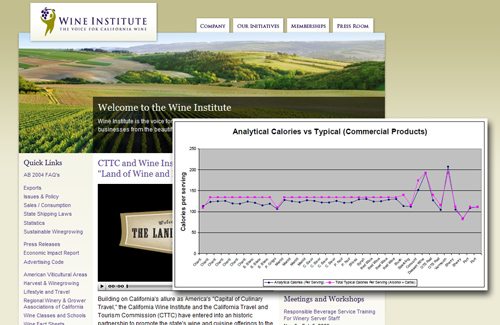It is likely that all beer, wine and spirits labels will change dramatically in the near future. TTB has been working on new rules since CSPI and other groups submitted a petition in 2003. The new rules would require a “Serving Facts” panel on every container. This panel would include a lot more information, such as the typical serving size, number of servings per container, calories, carbohydrates, protein and fat. Because this is a big, controversial change, TTB has received more than 18,000 public comments during the past few years. There are far too many comments for most people to review, and so we will highlight and summarize the most noteworthy comments here. The most recent proposal and comments are here. This is comment 8 in a series; to see others, click on the “serving facts” tag below.
Wine Institute is the trade association of over 1,000 California wineries and affiliated businesses. Wine Institute’s 34-page comment said:
- Serving facts should not be required. 20 years after putting similar information on food labels, at a cost of about $2 billion, Americans are more obese than ever.
- Some comments link the US Dietary Guidelines with a “standard drink.” This is inappropriate because the term has never appeared in any edition of the Guidelines.
- The 18,000 or so form-generated comments, in response to the advance notice, should carry little weight. They lack credibily and sincerity.
- TTB should maintain the allowance for some wines to refer to “table wine” rather than requiring a more precise alcohol by volume statement “across the board.” The more flexible rule saves wineries money by allowing them to print labels well in advance.
- The 5 ounce serving size for wine should apply to wines up to 16%, rather than 14%.
- TTB should allow “typical values” rather than lot-by-lot analytical values; there is very little gap. Testing every type could cost a medium-sized winery $125,000 per year. This would impose a severe and much higher burden on the wine industry, compared to beer and spirits, because wine is “inherently variable in composition.” Lot-by-lot testing would also lead to substantial delays, as winemakers attempt to twist the blend to conform to the label.
- A three year phase in is helpful but by no means removes the costs. The serving facts panel is likely to require larger labels (about 40% larger). Larger labels could add 0.5 to 1 cent per bottle in label costs alone. A linear format would help and should be allowed.




I think the observation that serving sizes have done nothing to help Americans stay healthy is an apt one. People don’t get drunk because of ignorance, they get drunk because they want to. This change is only going to cost everyone more money and make life harder than it already is.
I whole heartedly agree with the fact that wine is more variable. The cost is only going to be passed along to consumers, and for what benefit? Are you going to pick a wine just because it is lower in carbohydrates by 1 gram per serving? I seriously doubt it.
Furthermore, it opens up the possibliy to expand the labeling requirements in the future, to include a list of ingredients. Wine inherently is not just fermented grape juice, there are may additions that winemakers add to enhance the flavor( all of which are permissable by the TTB). It would destroy the whole mystique behind wine if it were required to be listed.
C’mon, do you want to know that egg whites were used to fine out the protien, or worst bentonite (essentially processed dirt)? Does it truely matter, becasue it all settles out or is filtered out. There is possibly only trace amounts in the finished product, if that.
I think alcoholic beverage labels are fine just the way they are. They give the consumer the information you want to know, type of beverage, and alcohol level. Beyond that, who cares?
its nice article, i agree
This is not a consumer protection issue. It is a consumer educaton issue.
Encourage the TTB to publish the nutiriaionl content of a typical 750ml bottle of wine on its website. Require wine labels to refernece this website.
It is insane to think that each wine should be individually tested to determine its nutritional content when (within a very limited range) we will all be putting the same values on our proudcts.
The consumer should know how wine stacks up against other proudcts they consume, but there is absolutely no reason to attempt to differtiate between individual bottles of wine because there is no differnce.